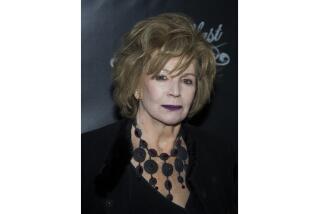Jane Austen as a Woman of the World : JANE AUSTEN Her Life <i> by Park Honan (St. Martin’s/A Thomas Dunne Book: $24.95; 452 pp.) </i>
- Share via
The great Victorian poet, Alfred, Lord Tennyson, one of the many admirers who compared Jane Austen’s genius with Shakespeare’s, was reported to have “thanked God Almighty with his whole heart that he knew nothing, and that the world knew nothing of Jane Austen, and that there were no letters preserved either of Shakespeare’s or of Jane Austen’s, that they had not been ripped open like pigs.” He spoke too soon. Within the decade, Caroline Austen offered recollections of “My Aunt Jane Austen” (1867) and Caroline’s brother, James Edward Austen-Leigh, an often-to-be-reprinted “Memoir of Jane Austen” (1870). Biographies followed apace. As for letters, Jane’s acerbic epistles to her sister, Cassandra, have shocked--or at least dismayed--many readers who had formed a more appealing image of Austen from the brighter, subtler, wiser, more graceful voice that narrates her novels.
The disparity between what an artist--particularly a novelist--actually experiences and the final work of art is a contrast based on a linked relationship. At the heart of this biography by Park Honan (who has also written biographies of Matthew Arnold and Robert Browning) is a quest to clarify the disparity, that relationship. Honan is not out to psychoanalyze Jane Austen, but rather to provide as much data about her life as can be pieced together from research, so that we can survey the raw materials--indeed, the very world--from which she created her novels.
An American who is a professor of English and American literature at the University of Leeds in England, Honan has truly immersed himself in Austeniana. By returning to primary sources, such as the original holographs of her letters, he is able to correct errors of previous biographers and editors. His extensive research, including a close perusal of materials in the hands of Austen family descendants, yields significant details, not only about Jane and her immediate family (kindly, reserved, clerical father; witty mother; six brothers and her beloved sister Cassandra), but also about her extended family, her confidantes, friends, and acquaintances, who all contributed their share of variety and distinctness to the orbit of Jane’s experience.
From the romantic exploits of her cousin Eliza de Feuillide, whose French aristocratic husband was guillotined in the Reign of Terror, to the nautical adventures of two of her own brothers, Jane Austen had a more wide-ranging sense of the world in which she lived than some critics have recognized. Although her novels concentrate on the nuances of personal relationships and the “feminine” world of love and marriage, Honan rightly reminds us, they do not exude a “hothouse atmosphere.” And this, he believes, is because her novels incorporate some vestige of a broader perspective, from the militia and wartime atmosphere in the background of “Pride and Prejudice” to the effects of a plantation in Antigua on the family in “Mansfield Park” and the strong presence of the Royal Navy in “Persuasion.” Honan fills in the details of this wider world.
Austen herself proves more elusive. But Honan’s research discloses more about her private life, with full accounts of her romances. She was not immune from the errors that beset even her sillier characters. Her rash flirtation with the attractive but impecunious Tom Lefroy (whose family had determined he would have to marry money) set neighborhood tongues wagging. Later, she suffered a deeper embarrassment in first accepting, then rejecting (the very next morning) the proposal of Harris Wither, who was so suitable from a family and financial viewpoint, but so very unsuitable in the eyes of a woman who feared dependency and spinsterhood--”to be old and poor and laughed at,” as she once put it--but who still believed in the importance of romantic love.
In his eagerness to invest distant details from the past with vivacity, Honan writes with a kind of forced sprightliness that can be distracting as well as amusing. His knowledge, clearly, is extensive and his judgment thoughtful, but he sometimes fails to distinguish between conclusions based on firm evidence and those that are only informed speculations on his part.
He understands well the importance-- and the indirectness --of the link between life and art. In the variegated life he presents, we see the rich palette Austen had to work with, and we also see the vast differences between these raw materials and the characters, plots, dialogue and incidents she created (not copied) from nature. The degree of creativity involved in her believable, lifelike, eminently realistic novels is easy to underestimate, particularly when compared with the more obvious creativity involved in writing fantasy, Romantic epic or Joycean and Yeatsian mythopoeia. But creating a semblance of reality involves the imagination: As Jane cautioned a niece who had also taken up writing, an incident drawn from real life, no matter how true, no matter how faithfully transcribed, will often not seem “probable” or “natural” in fiction. And if it does not, the fiction will fail.
Honan’s fine appreciation of Austen’s “technical mastery, intensity, lightness” complements his painstaking evocation of her life. Jane Austen had the gift of lightness, a quality praised by the late Italo Calvino in one of the lectures he was preparing shortly before his sudden death to deliver in the Charles Eliot Norton series at Harvard University. As Calvino explains it, lightness is not superficiality, but the means by which an artist transforms the heaviness of life, the opacity of the material world, and the constraints of society and custom into the lighter, clearer, more flexible and orderly realm of intelligence and art. The lightness, clarity and radiance of Austen’s art are manifestly there in her novels for all who have eyes to see, hearts to comprehend. She was not a “personality” like Byron or Oscar Wilde, whose lives are part of their lasting myth. Reading her biography does not increase our pleasure in her art. But it can deepen our admiration for her artistry, the difficult process by which she transformed the heaviness of life into the lightness of art.
In this biography, Honan has spared no effort in his attempt to show us as many aspects of Austen’s world as he can, probing, but not prying, displaying sense and sensibility all the while. Perhaps even Tennyson might not have disapproved entirely.
More to Read
Sign up for our Book Club newsletter
Get the latest news, events and more from the Los Angeles Times Book Club, and help us get L.A. reading and talking.
You may occasionally receive promotional content from the Los Angeles Times.









